概述:讲了公司里常见的几种项目管理组织布局。如果对项目管理有兴趣,推荐从PMBOK入门,考试题多出于此。翻译理解有误烦请指出。
1. 职能型:各部门的部门经理就是项目经理,直接向VP汇报。各项目都由本部门控制,跨部门合作需通过经理。借调人员需经过人事经理。
2. 项目型:以提供某些咨询或服务为商业模式的公司为主。项目经理直接向CEO汇报,有极大权力。每个项目成员向项目经理汇报。项目结束后人员闲置,新项目上马人员重组。人事和财务也归项目经理管。
3. 矩阵型:对以上两种布局扬长避短。
(1) Weak型:类似职能型。但有项目协作者,权力很小或无权。
(2) Balanced型:在项目期有兼职项目经理。
(3) Strong型:类似项目性。全职项目经理有实权。在项目期,成员解除职能任务,项目结束后,回归职能部门经理管辖。项目经理必须和部门经理紧密合作,不能分配成员的所有工作时间。
Organizational Structure within a Company for PMPs
Introduction
This article is about how various companies are organized with respect to project management. You should be able to find your company in one of these structures. If you have ever read the PMBOK (Project Management Book of Knowledge), this is discussed in detail in that book if you want to read more.
Organizational Structure
The reason to understand these structures is to better help you manage your projects. Once you know how your company is structured, you can then see how best to help your project based on how things work. Each type has its pros and cons. You need to know both to be an effective project manager.
The first structure is called a Functional Organization. This structure has one manager in each department. This is probably a Vice President if this is a good size company. There may be one or more managers under the VP to support the various sub-departments. Each department works independently of each other and if they need to coordinate, they can work through their managers. The project team can all have different managers. Each part of the project is handled in its own department. If an interdepartmental need arises, the managers will assign the appropriate tasks and coordination. Project managers have other responsibilities than just being a project lead. If the project manager needs a team member to do something, she/he should go to the person's manager.
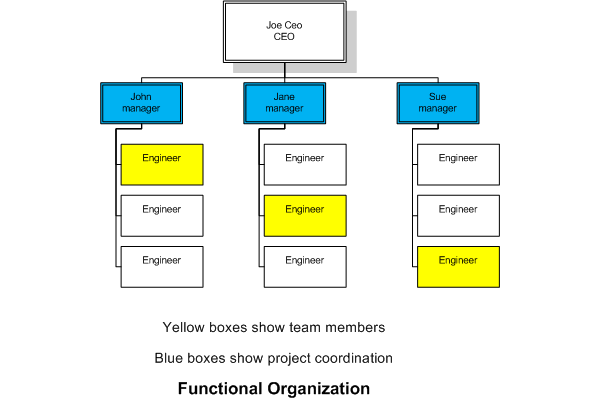
The next one is called a Projectized Organization. This is where a Project Lead reports to a CEO or someone else who has a lot of authority. The project staff all reports to the Lead. This would be for a company that does projects as a main part of their business, most resources are involved in project work. This would be a good organization for something like a professional services company. Since the project lead has the team reporting to him/her, he/she has a lot of authority. Usually, supporting functions like accounting and human resources report to the project lead as well. At the end of the project, the team members are reassigned.
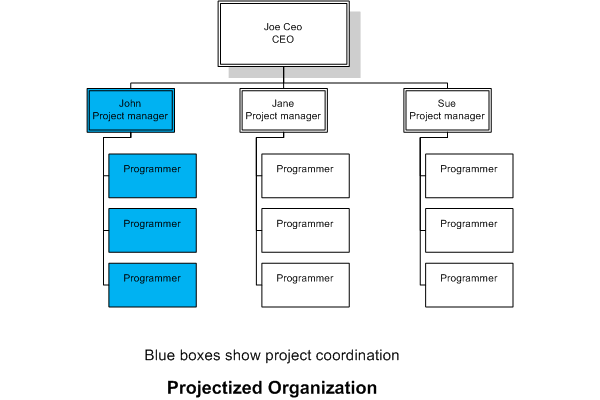
Another structure is called a Matrix organization. The concept is to take the best of the previous two and minimize the disadvantages to make one organization structure. This layout has a weak, balanced, and strong matrix. The weak is somewhat similar to the Functional but has a project coordinator assigned. The coordinator usually has little or no authority since she/he cannot tell someone from another department what to do. The balanced matrix has a project manager but is not full time. The company knows it needs a project manager but will not have one full time. A project manager may only be appointed for the project duration and would not have much authority over the team. A Strong matrix is similar to a projectized organization. There is a full time project manager with some authority. While working on a project, team members are relieved of their functional duties. At the end of the project, they are reassigned to their functional managers. This way you get the best of both organization types. The project lead must work closely with the functional manager so as not to over allocate the team members' time.
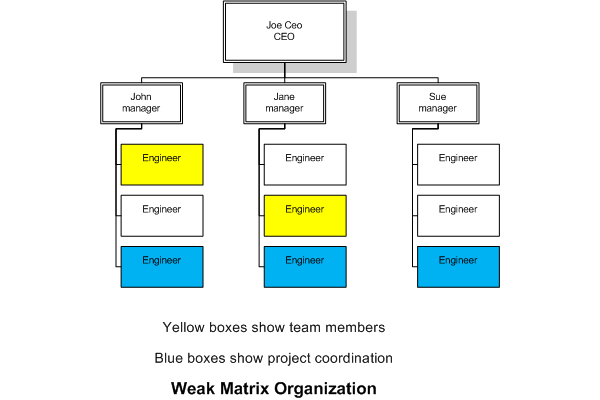
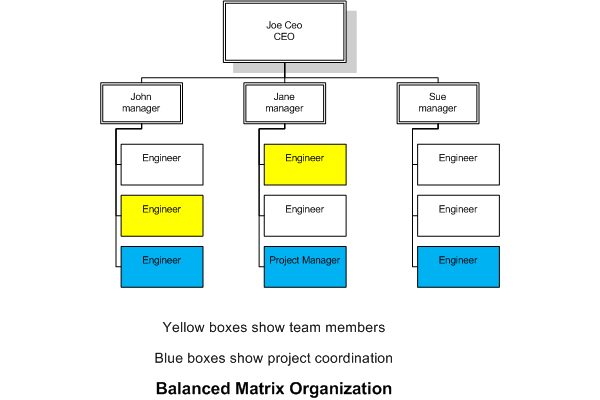
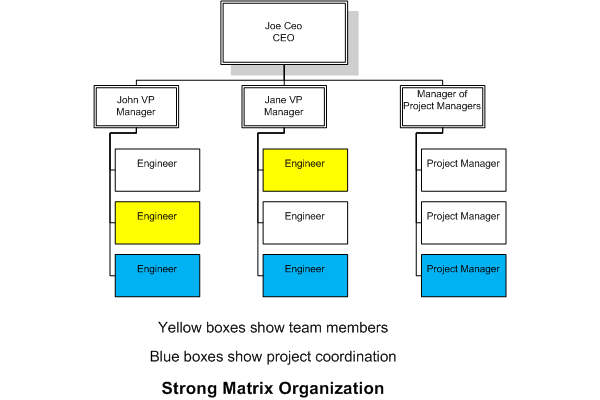
Most companies will have some variation of the above organization layouts.
PMO
Many companies see the benefit of a PMO (Project Management Office). Although it is usually associated with a company that does multiple simultaneous projects, a PMO can exist in other forms than the ones that are shown. The distinct characteristic is having a Project management department or office. They oversee the management of projects. A key part of this is that they have authority over the project, sometimes acting as a stakeholder.
Points of Interest
If you are interested in this and want to lean more, the PMBOK is a place to start. This is the book that is used to study for the PMP exam. In any course that you take to study for the exam, this is the book to study from. Almost all of the questions will come from this book. It is not what most would consider a page-turner but if you want the certificate, this is the book to study from. When I took the course, I also had to buy another book to read in more detail about what was going on.



















